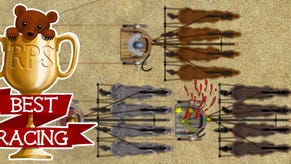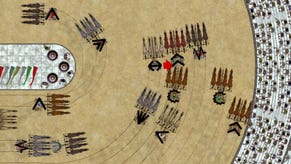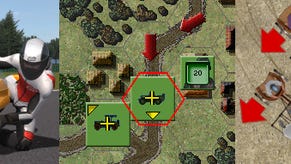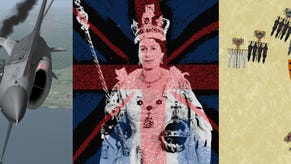Wot I Think: Qvadriga
Chariots of Ire
Turn-based games are the best games. With that fact established, let us acknowledge how unfortunate it is that so many turn-based games focus on a small set of activities, mostly involving military squads, or rapidly expanding kingdoms and galactic federations. Conquest and combat. Qvadriga is different. It is, as far as I know, the first turn-based game about chariot racing in the circuses of the Roman Empire. By breaking a complex and unusual scenario down into a series of tense decisions can Qvadriga find the game at the heart of The Games?
I love the smell of horse meat in the morning. Smells like victory. But the first time I killed a gee-gee, I felt terrible. It was an accident. I'd ordered my chariot to ram an opponent who was hurtling down the outside lane, just to my right, but I hadn't expected the horses to be a legitimate target. My vehicle was a sturdy construction, built with the finest materials a Mercurial merchant's denari can buy. Though all chariots have a team of four horses and a single driver, my machine was a raging juggernaut in comparison to the flimsy balsa-basket rattling alongside.
Desperate to pass, he flayed his horses, blood and foam forming a pink mist in the air around them. The timing of my ‘crash’ order was perfect though and before his speedster could overtake, my chariot slid to the right, our wheels crunching together. He took a huge amount of damage and lost a great deal of speed. Suddenly, my cumbersome combat vehicle was overtaking his sleek little buggy. Mission accomplished. Or so I thought.
My auriga (driver) thought otherwise. He had his orders – to crush anything to the right of his chariot – and while the opposition driver was receding from view, the frenzied and brutalised horses were still attached to the splintering wreck. They strained to drag it forward, toward the finish line, or to escape from the harness, and were perfectly placed to receive the second crunching blow from my tenacious charioteer.
SPLAT.
A whinny is heard and a blotchy red blossom is all I can see from my managerial birds-eye perspective. When the dust clears, a horse can be seen lying in the dirt. It is curled into a foetal position. The crowd are going wild, but with delight rather than the fury of PETA the apoplectic. There’s horse-meat being ground into the arena floor but there’s no scandal to go along with it. Not this time. This bloody act is the stuff that champions are made of.
Examining that moment of equine elimination and the events that led up to it demonstrates every fine detail of a Qvadriga race. Let’s break it down.
Turns in Qvadriga resemble Frozen Synapse or, more closely, Ace Patrol. Orders are given and then everybody acts at the same time. However, the wait between moves is a few seconds, representing the speed of the chariots and the difficulty of reacting quickly to changed circumstances. This means a bad decision can commit a chariot to a suicidal or futile mode of action. For a while, this is distracting, making the player seem like an interested observer rather than the controlling force, but after surviving a few events, the precisions and predictions required by the system become sources of tension and pride.
Within a race, the interface is a miniature masterpiece, efficient and clear. Symbols appear alongside at the left, right and centre of the player’s chariot and their position explains which lane they are directed toward. So acceleration, breaking, defense and control commands are in the centre, while attacks and lane changes are on the right and left. There are only a handful of possible actions at any one time and after a few races, their uses are obvious.
There were eight chariots in the race that turned me from horse whisperer to horse wrecker, and despite a lack of pace, I’d managed to bully my way into the lead. As the idiot to my right tried to overtake, he had two options and he went for the risky one – speed. The alternative would have been to defend himself and his horses, fending off my attacks whether they came in the form of an intentional collision or a crack of the whip. Of course, I may have opted for speed myself, taking the whip to my own horses (still makes me wince, when blood bursts from them as they run), which would have made any defensive act on the AI's part a wasted move.
The AI is left with what seems like a simple binary choice but it’s a product of the actions of every rider during the earlier stages. The beginning of a race is a bit like one of those fairground attractions, in which toy camels or horses shudder along a track whenever a ball is thrown into a hole. Click accelerate and sometimes the ball lands in the hole but sometimes the horses don’t seem to react at all. The computer is rolling imaginary dice, no doubt, but the stats of each rider, horse and chariot are being tested against those rolls. Even when every team starts side by side, the early running isn’t quite as unpredictable as it seems.
But it’s at the first turn that the tactical battle begins. Effectively, races are divided into two equally important portions – straights and turns. Straights are used to position the chariot in a chosen lane, which often involves overtaking or otherwise dealing with opponents who are blocking that lane. Inside lanes are faster but undesirable because chariots are unsteady. Not just unsteady, actually. Once they hit a bend they’re about as stable as W.C Fields on a pair of stilts in a bouncy castle.
Because of their tendency to topple and the fragility of horse-flesh, it’s rare for every chariot to finish a race. By the third lap, every turn is likely to have the hazardous remnants of fallen competitors scattered across its width. Hit a turn at speed and an indicator appears at the side of the screen indicating the chance that control will be lost.
Because there’s no way to interrupt a movement phase once an order is given, the few seconds of watching a rider take on an ill-judged turn can be agony. Green means the chariot might veer one lane toward the outside, which shouldn’t be too much of a problem, but red means a wheel might buckle slightly or the entire vehicle might overturn, leaving a pile of wreckage and a driver hanging onto his horses’ reigns for dear life.
When a vehicle is destroyed, the rider is dragged along at the rear, with odd but satisfying cartoon stars spinning around his head. While stunned, he is strapped to the reigns and may perish before he has a chance to recover and unfasten himself, but even after he clears his head, the player can instruct him to endure rather than running to the safety of the trackside.
Telling a rider to hang on is usually a way to preserve his life, by waiting for a gap so he can run like Frogger between chariots rather than being squished beneath them. But, sometimes with a sick smile and more often with a condiment spread across my fingernails, I’ve also ordered riders to cling on while they’re scraping and bouncing along the ground – if they’re on the final lap and the finish is within reach, they might just cross the line before becoming a crimson stain.
The normal difficulty setting allows a driver to be ‘saved’ (resurrected really) but during an epic level campaign, dead is dead.Tactics vary depending on the skill of the auriga, and the qualities of his chariot and horses. Further complications arise in campaign mode, as a random event alters the course of the race. The course might have debris from a previous race scattered across it, making certain lanes more dangerous to occupy, or the officials in charge may have banned whips for one night only.
Here’s something that you can’t say about many racing games, turn-based or otherwise – in Qvadriga, you won’t always be trying to win first place. Depending on the strength of your stable, the power and number of your rivals, and any special conditions in place, it can be wiser to aim for a finish, in any position, rather than battling for the top spot. As long as the rider survives and the chariot crosses the line on the final lap, the owner takes some cash home. Changing tactics and objectives on the fly is an important part of the job, which is the mark of a simple but solid strategic layer.
Of course, those considerations only matter in campaign mode, during which the game ends if there isn’t enough cash remaining to maintain the team. The player can have up to four chariots, with horses and riders of varying ability and strength, and there are many arenas in which to compete, scattered across the Roman Empire. Travelling costs money but some regions carry a bigger purse, or supply robust chariots and special breeds of horse. Sadly, the interface during management is spare but unhelpful, with extra clicks needed to check information such as the number of entrants in a race when preparing a chariot. The shops are a clutter of symbols - functional once understood but initially arcane.
The aim is to reach Rome and win in the grandest race, all the while rising up leaderboards. I didn’t understand the strategy of the game’s management side at first but I do now. It’s about developing an individual auriga rather than an entire team – the rest are there to prop up the best - and also, brilliantly, entering races that the best riders in the world are taking part in so that you can try to maim or murder them. The road to the top is quite literally littered with the mangled remains of former champions.
Despite all the roads I’ve clogged with corpses, I haven’t found the one that leads to Rome yet. I really need a better sat-nav. I’m a little bit in love with Qvadriga though. Turn-based combat racing is a rare enough treat that I’d probably recommend it to anyone with the slightest interest even if the game weren’t so solidly constructed. Despite the quality of the race experience, the overall package does seem a little barebones at first, but the campaign is tough and variable, and the AI is smart without being entirely predictable. I crave multiplayer though, in any form.
It’s a game that deserves to be a success and perhaps it will be if people are willing to wander from the great forum of Steam. I wonder if it would gain more attention if it were based around a violent future sport, which it effectively is apart from the contrary chronology. Listen close and it’s almost possible to hear the vendors in the crowd shouting, ‘Quail eggs! Quail eggs!' And when the difficulty is set high and every turn is timed, every race is a potential font of glory and dismay.
Qvadriga is a fine game and a strong proof of Turnopia's approach. Built on easily understood mechanics, the game involves a dissection of a complex activity and then reconstruction as a process of distinct phases and actions. A few decisions and interlocked mechanics become a convincing recreation. Gladiators next? Or perhaps early motorsports and an eventual turn-based history of vehicular competition.
Qvadriga is available now, as is a demo.














